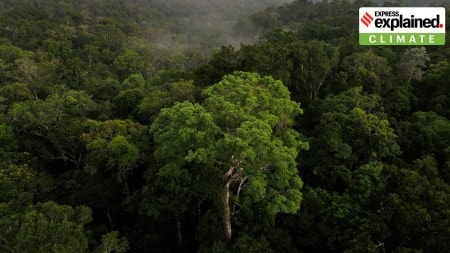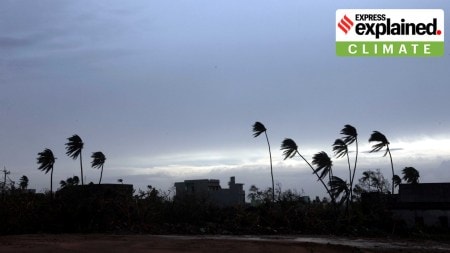EXPLAINED CLIMATE NEWS - Page 2
Amazon rainforest trees are getting bigger due to climate change: What a new study saysSubscriber Only
The findings are significant as trees which have become bigger can absorb more carbon than in the past.
Why China’s plan to reduce its emissions is significant for climate actionSubscriber Only
China’s President Xi Jinping, making an appearance at the event through video-conferencing, finally unveiled his country’s plans to reduce its greenhouse gas emissions, and set a target of 7-10 per cent cuts by the year 2035 from its peak levels
What made Super Typhoon Ragasa so intense?Subscriber Only
Super Typhoon Ragasa, Ragasa Hong Kong impact: The storm is the most intense tropical cyclone recorded in 2025. At its peak, Ragasa was moving with the maximum sustained winds of 280 kmph.
Topography, climate change: Behind the heavy rain in Uttarakhand, HimachalSubscriber Only
Extreme rainfall or cloudbursts have led to landslides, mudslides, flash floods, and swollen riverbanks, resulting in large-scale destruction, loss of life, and communication disruptions.
Carbon emissions from fossil fuel companies linked to numerous deadly heatwaves: What a new study saysSubscriber Only
The study analysed 213 heatwaves that occurred worldwide between 2000 and 2023. It showed that due to global warming, heatwaves between 2000 and 2009 became about 20 times more likely, and about 200 times more likely between 2010 and 2019
Collapse of critical Atlantic current is no longer low-likelihood: What a new study saysSubscriber Only
The analysis has said the tipping point that makes an Atlantic meridional overturning circulation (AMOC) shut down inevitable could be breached within a few decades. However, the collapse of the current itself may not happen until 50 to 100 years later
Deforestation in tropical areas caused 28,000 heat-related deaths a year in the last two decades: What a new study saysSubscriber Only
Tropical forests are some of the most biodiversity-rich environments on the planet. However, in recent decades, these forests have faced large-scale deforestation.
Melting of Arctic sea ice has slowed down. This is not ‘good news’Subscriber Only
Despite the unprecedented increase in global temperatures, the melting of Arctic sea ice has slowed down over the last 20 years, according to a new study. However, scientists say this is only a temporary event, and the melting may resume at a more rapid rate
Mumbai heavy rainfall 2025: Why city is witnessing wettest August in 5 yearsSubscriber Only
Mumbai IMD weather alert, Mumbai heavy rainfall 2025: In less than a week, Mumbai has surpassed the monthly average quota of rainfall for August. In fact, the rainfall this week is nearly at par with that in the whole of July, generally the city's wettest month. Here's why
Kishtwar flash flood: How climate change has contributed to extreme weather events in J&KSubscriber Only
550 people have been killed in 2,800 extreme weather events in J&K from 2010-22. Disasters like the flash flood in Kishtwar have been driven by rising temperatures, changes in the nature of western disturbances
The spineless foe of nuclear power plants: How jellyfish disrupt these facilitiesSubscriber Only
Since at least the 1990s, nuclear power plants across the world have been forced to shut down due to jellyfish getting clogged in their cooling system. Such incidents are now on the rise as climate change and marine pollution have increased the jellyfish population.
Dharali disaster: the complex, uncertain relationship between extreme rain, landslides & flash floodsSubscriber Only
Not all cloudburst-like events result in a flash flood or a disaster. And not all flash floods are triggered by an intense spell of rain. The Uttarkashi incident demonstrates the rising risk of disasters in ecologically fragile regions, and the increasing uncertainty around their occurrence. This makes the task of installing early warning systems and taking mitigation measures even more difficult.
How to reduce risks from glacial lake bursts and carry out effective rescue operationsSubscriber Only
The Dharali flash flood in Uttarkashi could have been caused by a phenomenon known as GLOF. Five years ago, a document prepared by the NDMA had identified this risk in the Himalayas, and laid down detailed guidelines on ways to anticipate and deal with GLOF emergencies. Here’s what it said.
What caused Uttarkashi flash floods: Heavy rainfall, rugged topographySubscriber Only
Uttarkashi flash floods 2025 explained: The primary reason is the topography of the area, where heavy rainfall often results in landslides, sending mud and concrete into the rivers.
Increase in coal production capacity dipped in 2024: What does it mean for net-zero targets?Subscriber Only
Last year, the amount of production capacity that came online stood at 105 mtpa — a 46% decline from 2023, when the amount was 193 mtpa. In fact, the 2024 increase was the smallest production capacity increase in a decade
Why the ICJ’s advisory opinion on climate change opens the window for a new, restorative vision of environmental law in IndiaSubscriber Only
A profound thread runs through the judgment and the separate opinion of one of the judges: that biodiversity is not merely a passive victim of climate change but a legal and ecological actor in its own right. This vision carries powerful seeds of change in our collective future
What the ICJ ruling means for the Kyoto ProtocolSubscriber Only
After the Paris Agreement came into effect in 2016, it was understood that the 1997 Kyoto Protocol had lost its legal relevance. However, the ICJ has now said that the treaty remains valid, and countries have to comply with its provisions
Why Kamchatka in Russia is especially vulnerable to massive earthquakesSubscriber Only
Kamchatka Earthquake News: The July 30 earthquake occurred due to tensions along the subduction faultline between the Pacific and the Okhotsk tectonic plates. The area is part of the Ring of Fire, a zone of earthquakes and volcanoes. Here’s the background you need to know.
How flash floods are affecting IndiaSubscriber Only
Flash floods lead to the death of more than 5,000 people annually in India. With soaring global temperatures, they are expected to increase in frequency and become more intense. A study has put the spotlight on areas that are most vulnerable to flash floods, and how authorities can limit their impact
Why increasing renewable energy alone can’t solve climate crisisSubscriber Only
In recent years, the world has witnessed a boom in the growth of renewable energy capacity. However, this has not reduced the use of fossil fuels, which has led to an unabated rise of greenhouse gas emissions.
Why ICJ ruling on climate change is significantSubscriber Only
The court has held that countries are under a legal obligation to take steps to reduce greenhouse gas emissions. The ruling is not binding — but it could move the needle on international climate action
India reaches key climate goal 5 years ahead of target: The full picture, explainedSubscriber Only
Less than 22 per cent of India’s total energy consumption is done in the form of electricity. The rest happens through direct burning of fossil fuels such as oil, coal and gas
What is the European Union’s CBAM, and why has BRICS condemned and rejected it?Subscriber Only
Europe’s carbon border tax is an import duty on a product manufactured in a country that has more lax climate rules than the EU. The ostensible purpose is to check ‘carbon leakage’, but the tax makes items like steel or cement manufactured in countries like India more expensive, and thus less competitive, in European markets.
Why the UNFCCC process must be reformedSubscriber Only
In recent years, climate negotiations have failed to achieve sufficient progress in tackling climate change and its impact. Several ideas have been proposed to reform these talks but it’s unlikely that they will be implemented
How melting glaciers can lead to more volcanic eruptionsSubscriber Only
Sustained volcanic eruptions can release large amounts of greenhouse gases, including carbon dioxide and methane, which could further heat the planet
BEST OF EXPRESS




Must Read


















































